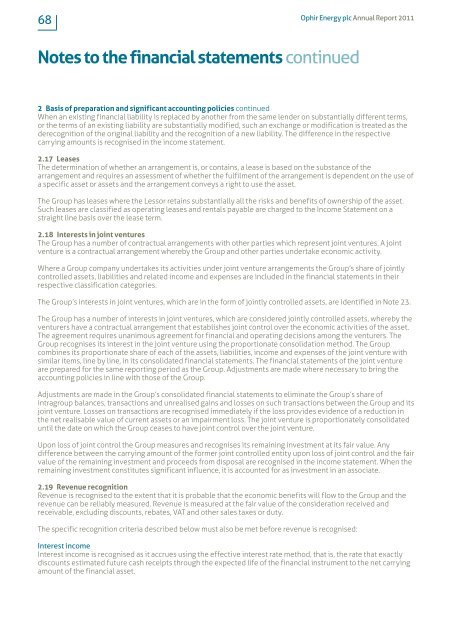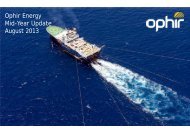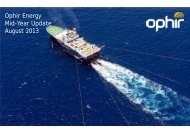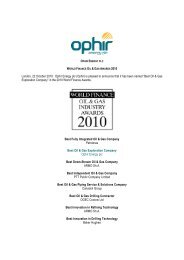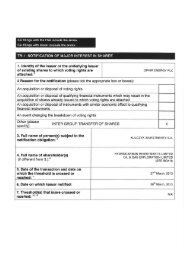Ophir Energy plc Annual Report and Accounts 2011
Ophir Energy plc Annual Report and Accounts 2011
Ophir Energy plc Annual Report and Accounts 2011
Create successful ePaper yourself
Turn your PDF publications into a flip-book with our unique Google optimized e-Paper software.
68<br />
<strong>Ophir</strong> <strong>Energy</strong> <strong>plc</strong> <strong>Annual</strong> <strong>Report</strong> <strong>2011</strong><br />
Notes to the financial statements continued<br />
2 Basis of preparation <strong>and</strong> significant accounting policies continued<br />
When an existing financial liability is replaced by another from the same lender on substantially different terms,<br />
or the terms of an existing liability are substantially modified, such an exchange or modification is treated as the<br />
derecognition of the original liability <strong>and</strong> the recognition of a new liability. The difference in the respective<br />
carrying amounts is recognised in the income statement.<br />
2.17 Leases<br />
The determination of whether an arrangement is, or contains, a lease is based on the substance of the<br />
arrangement <strong>and</strong> requires an assessment of whether the fulfilment of the arrangement is dependent on the use of<br />
a specific asset or assets <strong>and</strong> the arrangement conveys a right to use the asset.<br />
The Group has leases where the Lessor retains substantially all the risks <strong>and</strong> benefits of ownership of the asset.<br />
Such leases are classified as operating leases <strong>and</strong> rentals payable are charged to the Income Statement on a<br />
straight line basis over the lease term.<br />
2.18 Interests in joint ventures<br />
The Group has a number of contractual arrangements with other parties which represent joint ventures. A joint<br />
venture is a contractual arrangement whereby the Group <strong>and</strong> other parties undertake economic activity.<br />
Where a Group company undertakes its activities under joint venture arrangements the Group’s share of jointly<br />
controlled assets, liabilities <strong>and</strong> related income <strong>and</strong> expenses are included in the financial statements in their<br />
respective classification categories.<br />
The Group’s interests in joint ventures, which are in the form of jointly controlled assets, are identified in Note 23.<br />
The Group has a number of interests in joint ventures, which are considered jointly controlled assets, whereby the<br />
venturers have a contractual arrangement that establishes joint control over the economic activities of the asset.<br />
The agreement requires unanimous agreement for financial <strong>and</strong> operating decisions among the venturers. The<br />
Group recognises its interest in the joint venture using the proportionate consolidation method. The Group<br />
combines its proportionate share of each of the assets, liabilities, income <strong>and</strong> expenses of the joint venture with<br />
similar items, line by line, in its consolidated financial statements. The financial statements of the joint venture<br />
are prepared for the same reporting period as the Group. Adjustments are made where necessary to bring the<br />
accounting policies in line with those of the Group.<br />
Adjustments are made in the Group’s consolidated financial statements to eliminate the Group’s share of<br />
intragroup balances, transactions <strong>and</strong> unrealised gains <strong>and</strong> losses on such transactions between the Group <strong>and</strong> its<br />
joint venture. Losses on transactions are recognised immediately if the loss provides evidence of a reduction in<br />
the net realisable value of current assets or an impairment loss. The joint venture is proportionately consolidated<br />
until the date on which the Group ceases to have joint control over the joint venture.<br />
Upon loss of joint control the Group measures <strong>and</strong> recognises its remaining investment at its fair value. Any<br />
difference between the carrying amount of the former joint controlled entity upon loss of joint control <strong>and</strong> the fair<br />
value of the remaining investment <strong>and</strong> proceeds from disposal are recognised in the income statement. When the<br />
remaining investment constitutes significant influence, it is accounted for as investment in an associate.<br />
2.19 Revenue recognition<br />
Revenue is recognised to the extent that it is probable that the economic benefits will flow to the Group <strong>and</strong> the<br />
revenue can be reliably measured. Revenue is measured at the fair value of the consideration received <strong>and</strong><br />
receivable, excluding discounts, rebates, VAT <strong>and</strong> other sales taxes or duty.<br />
The specific recognition criteria described below must also be met before revenue is recognised:<br />
Interest income<br />
Interest income is recognised as it accrues using the effective interest rate method, that is, the rate that exactly<br />
discounts estimated future cash receipts through the expected life of the financial instrument to the net carrying<br />
amount of the financial asset.


